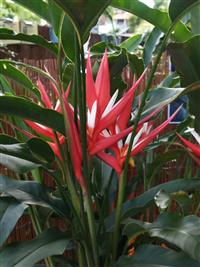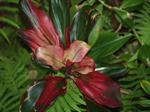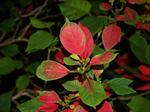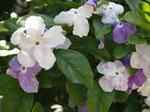Learn about identifying and growing Tropical Plants in different environments.
 Learn about plant names and classification - be able to identify different tropical plants.
Learn about plant names and classification - be able to identify different tropical plants.- Learn about soil types and plant nutrition.
- Study the growing of different tropical plants.
- Learn about landscaping with tropical plants - using colour and texture to achieve the desired effect.
- Learn about growing your own tropical garden.
- Engage in practical studies such as soil assessment and plant propagation.
- Course duration: 100 hours. Start at any time.
Some people would think a tropical is a plant that comes from the tropics. Others might consider tropical to also include plants from sub tropical places. This course concentrates on plants which originate from tropical or sub tropical climates, but there may be some plants covered which fit a looser definition of “tropical”.
Students studying the Tropical Plants course will cover areas of study including: plant names/classification (scientific and common), climatic conditions, plants suited to your locality; cultural practices: understanding soils, naming a soil, propagation, watering, feeding, pruning etc. Growing tropical plants outside the tropics and indoors - in different climates and conditions.
The course also covers the following plant types: tropical annuals, perennials, bulbous plants, bamboos, lawns, climbers. shrubs and trees also ornamental gingers and heliconias and related plants; cordylines, palms and cycads, orchids, ferns, aroids and bromeliads; tropical herbs, vegetables and fruit bearing plants.
COURSE STRUCTURE AND CONTENT
 There are 10 lessons in this course as follows:
There are 10 lessons in this course as follows:
Lesson 1. Introduction to Tropical Plants
- What does the term "tropical" mean?
- What tropicals grow where you live?
- Plant names/classification (scientific and common).
- Species, hybrids, varieties and cultivars.
- Growing Tropical Plants in different climates: tropical, sub tropical, arid and temperate.
- Climatic Variations; seasons, mountains, savannahs, rainforest, coastal.
- Gardening for Warm Climates and Microclimates.
- Good and Bad News about Tropical Gardening.
- Heat Traps, Warming a Garden, Greenhouses.
Lesson 2. Plant Cultural Practices
- Common Gardening Problems.
- Understanding soils, naming a soil, texture, pH, fertility, nutrition, feeding.
- Water and Plant Growth.
- Water deficiency and excess symptoms.
- Water Dynamics in a Soil.
- Planting and Plant Establishment Methods.
- Light Requirements.
- Mulches.
- Tree Guards.
- Weeds.
- Propagation,cutting, seed, propagating media.
- Potting Mixes, Potting up, Caring for young plants.
- Pruning etc.
Lesson 3. Tropical Annuals, Perennials, Bulbous Plants, Bamboos And Lawns
- Bamboos, Grasses and Grass Like Plants.
- Landscaping with Bamboos.
- Review of Bamboo species.
- Review of other herbaceous tropicals, including: Achmines, Agapanthus, Alocasia, Amorphophallus,Aristea, Babiana, Boophone, Brunsvigia, Caladium, Calaqthea, Calostemma,Clivia, Calocasia, Crinum, Crocosmia, Cyrtanthus, Dierama, Eucharis, Eucomis, Gladiolus, Gloriosa, Zephranthes, Hippeastrum, Hymenocallis, and many others.
- Lawns.
- Turf Varieties for Warm and Hot Areas.
Lesson 4. Ornamental Gingers and Heliconias (and related plants)
- Introduction
- Zingerbales; Musaceae (bananas), Strelitziaceae (bird of paradise), Lowiaceae, Heliconiaceae (heliconias), Zingiberaceae (gingers), Costaceae (costus), Cannaceae (cannas), Marantaceae (prayer plants).
- Gingers.
- Heliconia.
- Costus.
- Canna.
- Strelitzia.
Lesson 5. Cordylines, Palms And Cycads
- Types of Palms; self cleaning, cleaning, solitary or clumping, fan or pinnate, etc.
- Palm Propagation.
- Review of many cultivated Palm Genera.
- Cordylines.
Lesson 6. Climbers, Shrubs And Trees
- Review of many cultivated Tree and Shrub Genera.
- Cultural Requirements.
- Review of many selected species characteristics.
- Conifers; culture, genera, species.
- Climbers; Allamanda, Antigonon, Aristolochia, Beaumontia, Bignonia, Bougainvillea, Campses, Ceropegia, Cissus, Clematis, Clerodendrum, Clitoria, Clytostoma, Combretum, Congea, Ficus, Hoya, Ipomea, Manettia, Mucuna, Pandorea, Philodendron, Scindapsis, Stephanotus, Thunbergia, Trachelospermum.
Lesson 7. Orchids, Ferns, Aroids and Bromeliads
- Orchid introduction.
- Growing Orchids.
- Epiphytes.
- Orchid Genera.
- Bromeliads.
- Growing Ferns.
- Types of Ferns; Fern Classification and families.
- Fern Culture.
- Aroids.
Lesson 8. Tropical Herbs, Vegetables and Fruit Bearing Plants
- Growing Methods; organic, no dig, permaculture, Container Growing, Hydroponics, etc.
- Culture of Selected Vegetables in tropical and sub tropic conditions.
- Bush tucker.
- Tea and Coffee.
- Tropical Fruit trees.
Lesson 9. Growing Tropical Plants outside the Tropics
- Growing tropicals indoors.
- Growing in different climates and conditions.
Lesson 10. Landscaping with Tropical Plants
- Use of colour and texture.
- Plant selection.
- Planting a courtyard.
- Preparing sketch plans.
A VERY PRACTICAL COURSE
 Tropical Plants is a very practical course, where you will learn by doing things such as the following.
Tropical Plants is a very practical course, where you will learn by doing things such as the following.
- Research the climatic factors and ranges of your district. You may need to contact the Bureau of Meteorology or your local weather station. Record figures such as average monthly temperatures, rainfall, humidity readings, etc.
- Walk around your local area. Observe the plants that grow in gardens and on commercial properties. Are these plants typical of tropical landscapes as you would expect? Do you think the planting are suitable for the climate?
- Carry out a simple test on the soil of your property to determine it's type (e.g. sandy loam, clay). Write up the outcome and submit a description of your soil with your assignment.
- Select different tropical plants. Propagate these plants either using cuttings, layering, seeds, or division. Take a photo/s of this set task, or submit drawings of your cuttings/seedlings, showing exactly their size, the amount of stem, and the location and quantity of leaf. Submit a report explaining the techniques you performed.
- Do further reading into any group of plants that you have an interest in which you know is grown in cooler climates, for example roses. Identify how books and gardeners care for these plants in that climate. Would they be treated differently in a tropical climate? If so, how?
- Prepare a brief report on at least two plant types that require different cultural practices in tropical climates compared to when they are grown in cooler districts.
WHERE CAN YOU GROW TROPICALS?
 Many of our most magnificent gardens are found in hot places. The heat and humidity in sub-tropical and tropical areas provides moister areas that encourage diversity of plant life; the range of plants available for such situations provide a palette of unique textures, often brilliant colours and wonderful shapes. With the right approach and careful selection of plants, a once hot and unwelcoming place can be turned into a very beautiful and liveable garden.
Many of our most magnificent gardens are found in hot places. The heat and humidity in sub-tropical and tropical areas provides moister areas that encourage diversity of plant life; the range of plants available for such situations provide a palette of unique textures, often brilliant colours and wonderful shapes. With the right approach and careful selection of plants, a once hot and unwelcoming place can be turned into a very beautiful and liveable garden.
Tropical plants are not just restricted to tropical locations though. They also give us many of our most popular and successful house plants and greenhouse plants.
Even warmer parts of a garden in a mild temperate climate can sometimes become an ideal location for growing tropicals. Courtyards and other protected places can become heat traps, catching warmth and protecting from cold.
Greenhouses
A greenhouse is simply a structure or building used to provide suitable growing conditions for particular plants that could not normally be grown, or could only be grown with difficulty, in the outside environment. Tropical plants are most commonly grown as greenhouse or indoor plants in cooler climates.
Heat –Traps
Hot spaces are sometimes created intentionally (as well as unintentionally), in cooler climates.
- Poorly ventilated areas (e.g. a walled or fenced in garden space such as a courtyard), will not cool down as readily as more exposed sites, and can become a heat trap. Small, enclosed areas are more likely to act as a heat trap. Walls which face the sun (e.g. north facing in the southern hemisphere), tend to heat up faster than walls not exposed to as much sunlight; and they then radiate heat back over the day into the adjacent garden.
- Paving or concrete heats up much more than grass, and can also produce a lot of glare it can also reflect light and therefore heat onto windows and buildings. Unlike grass, paving absorbs heat during the day and releases it at night, so the area will stay warmer or hotter for longer than grassed areas. These situations can cause hot areas that are intolerable to use during the day. At night however they can be pleasantly warm; such a spot can also be used to advantage in order to grow heat loving plants.
- Large ponds or pools can have a moderating effect on the local temperature. As the water heats during the day from the effect of sunlight some will evaporate lowering the temperature in the immediate area. In addition some of the incoming heat will remain in the water to be radiated back into the atmosphere at night, once the sun has gone, helping to keep temperatures slightly warmer in the immediate area.
HOW THE COURSE WORKS
You can start the course at any time.
It is studied by distance learning, so you can study in the comfort of your own home. But this doesn't mean you are all alone in your studies. Our highly qualified and friendly tutors are there to help you every step of the way. If you have any questions at all, they are always happy to help.
Each lesson includes set tasks, and is completed with an assignment which the student submits to their course tutor. The tutor will mark the assignment and return this to the student with comments and suggestions for further reading.
STUDYING WITH ACS
At ACS we provide you with more than just a set of course notes.
Your 'learning package' includes:
- Course notes.
- Self-assessment quizzes.
- Assignment feedback.
- You can interact one on one with a professional tutor with decades of experience - just email, phone or log on to chat to connect with them.
STUDENT FEEDBACK
"This is the first correspondence course I have done and I have thoroughly enjoyed it and I just wanted to say a big THANK YOU. I appreciate everyone's effort in such a professionally-run organisation with seamless administration. The office staff's happy can-do attitude, their fast responses to all queries, tutor Shane Gould's quick turnaround in assignment marking and his supportive and motivational feedback and last but not least, the sound subject guides. Most importantly I hope my thanks and appreciation can be communicated to all the staff who have supported me along the way of my learning! I work full time and study on the weekend but really don't stop thinking about what gardening solution I need in order to answer my assignments every day of the week. Thank you for such a great learning experience and I can't wait to start the second half of my course!!"
- Skye, Student studying Tropical Plants
WHAT NEXT?
Register to Study - Go to “It’s Easy to Enrol” box at the top of the page and you can enrol now.
or
Get Advice – Email us at info@acsedu.co.uk OR
Use our FREE COUNSELLING SERVICE to contact a tutor